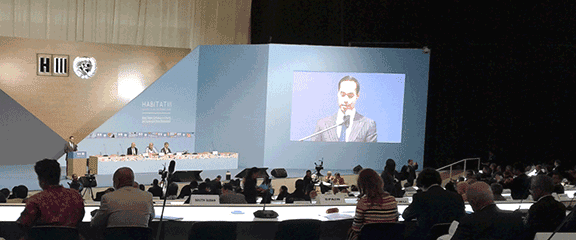 |
| by Jessica Jean-Francois Harvard Graduate School of Design |
 |
| Excerpt from New Urban Agenda display |
Having signed up for the newsletter over a year in advance, I had grown increasingly excited as I read about the research being done in anticipation of HABITAT III and the many meetings and events held to prepare for it as well. It was clear that this would be an incredible event and that I would have a unique opportunity to observe as key actors in city planning and urban policy came together, to hear about new approaches and practices, while also getting to know a new city.
 |
| HUD Secretary Julian Castro speaks |
Once there, I had plenty of activities to choose from. Main events included special sessions on public space, urban resilience and municipal finance. There were also networking and side events hosted by government agencies, nonprofit organizations and research institutions. There were roundtable discussions that brought together mayors, trade union leaders, businessmen and women, farmers and other key stakeholders. There were plenary meetings and many more events covering a wide range of topics, all happening simultaneously every day. On top of that, there was a six-hall exhibition zone with over 150 booths showcasing important ideas and activities related to urbanization.
For many people, all of this was overwhelming. Quito was completely transformed as much of the area surrounding the conference center could only be accessed via security checkpoints. Long lines, limited bathrooms and technical issues sometimes frustrated attendees.
 |
| Large lines formed at the event |
Now that I’ve returned and debriefed with classmates, friends, and others who attended the gathering, I am left with many questions. What were the intended takeaways? What was the point of such a large expensive conference? Who benefited, who lost? Also, could the conference’s goals have been achieved in a better way? While we celebrate that HABITAT III was open and free to all those who wished to attend, people still had to travel to Quito and pay for accommodations, food, and, if they wanted to highlight their work, for exhibition booths that cost $4,000 or more. Moreover, the selection process for hosting a side or networking event seemed arbitrary. While the New Urban Agenda clearly indicated that issues such as energy and transportation, land tenure, safety and security, disaster risk management and inclusion in spatial planning were concerns, particularly for those living in informal settlements and slums, this was not clearly aligned with the schedule of events on informal settlements, which primarily focused on the UN Participatory Slum Upgrading Program (PSUP) and data collection tools.
Despite these questions and concerns, I still believe the conference was valuable. While in Quito, I primarily attended events addressing informal settlements, which was a focus of MIT’s Special Interest Group in Urban Settlement (SIGUS), the group that I traveled with to the conference. I also attended sessions that focused on Small Island Developing States, tourism, economic development and finance to inform my master’s thesis at Harvard’s Graduate School of Design. Scheduling conflicts and long lines were at times a barrier to my hopes, but even these offered some interesting surprises. The long lines became an unintended networking opportunity and equalizer where people with different backgrounds and positions were able to meet, share ideas and connect. The exhibition halls were a hotbed of activity as people who sought a place to rest often became consumed in unplanned conversations and experiences.
 |
| Jessica at MIT's SIGUS booth |
That is how I got to know the Slum Dwellers International (SDI). Although I had previously been in contact with the group, on the last day of the conference, I heard an SDI celebration that featured singing and chanting. The participants were celebrating the launch of Know Your City a website featuring data collected by residents of informal settlements. SDI uses the data collection process to identify needs and encourage community-funded solutions. It also shares the data with policy members of their communities in an attempt to prevent evictions and prevent poor, top-down approaches to planning.
As I learned about this grassroots movement and about cases in Liberia, Zambia and South Africa, I thought about the many challenges that will hinder the effective implementation of the New Urban Agenda and the fact that many of the solutions to these barriers are present (but often hidden) in the communities it is supposed to serve. As we struggle to identify ways to make certain areas livable, it’s often forgotten that many people have already been forced to craft solutions in order to survive while only dreaming of gaining access to the resources needed to innovate on a larger scale. I am hopeful that many of the ideas and innovative approaches that were discussed and disseminated in Quito will help city dwellers take even more control of their own futures.
Jessica Jean-Francois, a second-year Master in Urban Planning student at the Harvard Graduate School of Design, was a Joint Center student research assistant in 2015-2016. Her trip was funded in part by Harvard’s David Rockefeller Center for Latin American Studies (DRCLAS) and the Joint Center for Housing Studies.

No comments:
Post a Comment